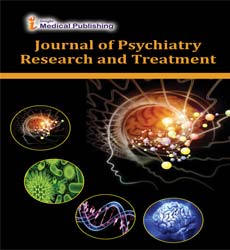Neurobiological Mechanisms of Depression: Advances in Diagnosis and Treatment Strategies
Christopher Harty*
Department of Psychiatry, University of New South Wales Sydney, Sydney, Australia
*Corresponding author:
Christopher Harty,
Department of Psychiatry, University of New South Wales Sydney, Sydney, Australia;
Email: christopher@harty.au
Received date: January 01, 2025, Manuscript No. Ipprt-25-20615; Editor assigned date: January 03, 2025, PreQC No. Ipprt-25-20615(PQ); Reviewed date: January 15, 2025, QC No. Ipprt-25-20615; Revised date: January 22, 2025, Manuscript No. Ipprt-25-20615(R); Published date: January 28, 2025, DOI: 10.36648/ 2471-7975.7.1.02
Citation: Harty C (2025) Neurobiological Mechanisms of Depression: Advances in Diagnosis and Treatment Strategies. J Psychiatr Res Vol.07 No.1: 02
Introduction
Depression is a multifactorial psychiatric disorder with complex neurobiological underpinnings involving genetic, biochemical, structural, and functional brain alterations. Despite being one of the leading causes of disability worldwide, its heterogeneous presentation has often limited early diagnosis and optimal treatment selection. Advances in neuroscience, neuroimaging, molecular biology, and computational psychiatry have provided deeper insights into the biological mechanisms driving depression, ranging from neurotransmitter imbalances to neural circuitry dysfunctions and neuroinflammatory processes. These discoveries are shaping more accurate diagnostic methods and fostering innovative therapeutic strategies beyond conventional antidepressants [1].
Description
At the core of depressionâ??s neurobiology are disruptions in monoaminergic systems, particularly serotonin, dopamine, and norepinephrine pathways, which influence mood regulation, motivation, and cognitive functions. Recent findings, however, emphasize that depression cannot be explained solely by neurotransmitter deficiencies. Dysregulation of the Hypothalamicâ??Pituitaryâ??Adrenal (HPA) axis, leading to abnormal cortisol levels and impaired stress response, has been strongly associated with depressive symptoms [2].
Additionally, neuroinflammation, driven by elevated cytokines and microglial activation, has emerged as a key pathological pathway, linking immune dysfunction to altered neuroplasticity and impaired synaptic connectivity Neuroimaging studies have further identified structural and functional changes in brain regions such as the prefrontal cortex, hippocampus, and amygdala, highlighting depression as a disorder of neural circuitry [3].
Reduced hippocampal volume and impaired connectivity in fronto-limbic networks correlate with emotional dysregulation and memory impairments commonly observed in patients. Advances in functional MRI and PET imaging have enabled researchers to uncover biomarkers that may differentiate depression subtypes and predict treatment response, paving the way for precision psychiatry. Moreover, genetic and epigenetic studies, including findings related to brain-derived neurotrophic factor (BDNF) and variability in treatment outcomes [4].
Therapeutically, these neurobiological insights have expanded treatment strategies beyond traditional Selective Serotonin Reuptake Inhibitors (SSRIs). Novel pharmacological interventions targeting glutamatergic neurotransmission, such as ketamine and esketamine, have shown rapid antidepressant effects by enhancing synaptic plasticity [5].
Conclusion
The exploration of neurobiological mechanisms in depression has profoundly advanced our understanding of its pathophysiology, enabling the development of more refined diagnostic tools and innovative treatment strategies. By moving beyond the monoamine hypothesis to include neurocircuitry dysfunction, neuroinflammation, and genetic regulation, research is transforming clinical approaches toward a precision-based model of care. Improved treatment outcomes, and a more comprehensive understanding of depression as both a brain and systemic disorder.
Acknowledgment
None.
Conflict of Interest
None.
References
- Jang SH, Woo YS, Lee SY, Bahk WM (2020) The brain–gut–microbiome axis in psychiatry. Int J Mol Sci 21: 7122
Google Scholar Cross Ref Indexed at
- Kelly C, Martin R, Taylor R, Doherty M (2024) Recognising and responding to physical and mental health issues in neurodivergent girls and women. Br J Hosp Med 85: 1–12
Google Scholar Cross Ref Indexed at
- Coello K, Hansen TH, Sørensen N, Munkholm K, Kessing LV, Pedersen O, et al. (2019) Gut microbiota composition in patients with newly diagnosed bipolar disorder and their unaffected first-degree relatives. Brain Behav Immun 75: 112–118
Google Scholar Cross Ref Indexed at
- Nguyen TT, Kosciolek T, Eyler LT, Knight R, Jeste DV (2018) Overview and systematic review of studies of microbiome in schizophrenia and bipolar disorder. J Psychiatr Res 99: 50–61
Google Scholar Cross Ref Indexed at
- Góralczyk-BiÅ?kowska A, Szmajda-Krygier D, KozÅ?owska E (2022) The microbiota–gut–brain axis in psychiatric disorders. Int J Mol Sci 23: 11245
Open Access Journals
- Aquaculture & Veterinary Science
- Chemistry & Chemical Sciences
- Clinical Sciences
- Engineering
- General Science
- Genetics & Molecular Biology
- Health Care & Nursing
- Immunology & Microbiology
- Materials Science
- Mathematics & Physics
- Medical Sciences
- Neurology & Psychiatry
- Oncology & Cancer Science
- Pharmaceutical Sciences
